In this comprehensive guide, we unveil 14 charming plecos that not only stay small but also bring a burst of color, pattern diversity, and functionality to your home aquarium. Join us as we explore these diminutive yet captivating bottom-dwellers, perfect for aquarists seeking a pleco for various smaller tank sizes.

Usually, a Common Plecostomus grows to between 15 and 24 inches and requires a tank that holds upwards of 100 gallons.
However, the dwarf plecos that I’m about to list below, will all stay small, even in their adult years.
Quick Sidenote: Do you want to watch this article instead of reading it? Checkout the highlight video below from our YouTube Channel (Or read the more detailed article below), be sure to Subscribe For More Great Fishkeeping Content:
That being said, let me show you the 14 small pleco fish that you could keep in your compact aquarium at home.
14 Small Pleco Species That Also STAY That Way
During my research for this list, I made sure to only cherry-pick plecos species that grow no more than 4.5 inches, with the smallest one reaching just 2 inches.
These Small Pleco Species fish add a distinctive appeal to aquariums due to their compact size and wide variety of colors and patterns. What distinguishes small species of plecos is their adaptability for different tank sizes, making them an exceptional choice for both novice and seasoned aquarists alike.
While this doesn’t sound like a lot, you should remember that these fish are bottom dwellers. Each of them will mostly occupy the bottom footprint of your fish tank, though some would also hang out on the glass.
A standard 10-gallon tank has roughly 20 inches of length and 10 inches of width. This equals a little over 1.6 feet in horizontal length that a single pleco fish species could explore.
The types of plecos that stay small are suitable for tanks of various sizes, ranging from nano tanks to large setups. If you have limited room or prefer a tank with densely populated fish, then the small species of pleco are a versatile option that doesn’t compromise beauty.
However, I would avoid housing Plecostomus breeds in 5-gallon tanks or anything smaller than that. If you’re looking for interesting fish that will fit a 5-gallon tank then click here to see some options.
That being said, have a look at the different types of plecos that could go in your aquarium:
1. Gold Spot Dwarf Pleco – Parotocinclus spilosoma
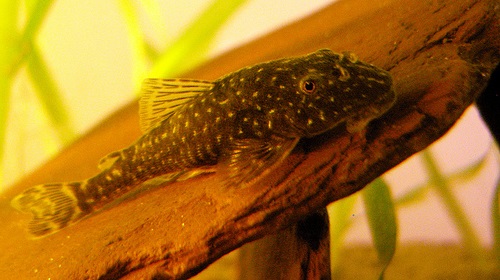
| Maximum Body Size: | 2 inches or approximately 5 cm |
| Minimum Tank Size: | 10-gallon tank for a school of 3 specimens |
| Suggested Water Temperature: | 71.5 to 82.5 °F (between 22 and 28 °C) |
| Key Traits: | Very peaceful; may bury itself in the substrate; will eat algae and biofilm |
| Suitable for Beginners: | Yes, as long as the beginner is familiar with the basics of fish keeping |
The Gold Spot Dwarf Pleco, scientifically known as Parotocinclus spilosoma, is a captivating species of freshwater fish that has gained popularity among aquarium enthusiasts throughout. This attractive fish, adorned with striking gold spots, boasts a unique combination of characteristics that make it a delightful addition to any aquarium.
Gold Spotted Dwarf Pleco is native to the river systems of South America, mainly in Brazil and Peru. These fish reside in slow-moving rivers and streams with sandy or gravelly substrates, where they can be found among rocks, driftwood, and aquatic vegetation.
The Gold Spot Dwarf Pleco remains small throughout its life and only reaches 2 inches of maximum body size. Such body measurements make this fish one of, if not, the smallest pleco species kept in home aquariums.
Their coloration varies from light brown to dark gray, with distinct gold spots scattered across their body, lending them a unique and eye-catching appeal.
Gold Spot Dwarf Plecos are well-known for their calm and gentle nature, making them a superb choice for novice aquarists and community tank setups. These fish are non-aggressive and generally prefer grazing on algae or resting in hiding spots. Their peaceful temperament makes them compatible with a wide range of tank mates, including peaceful community fish and invertebrates.
The Gold Spot Dwarf Pleco’s highly suitable for beginner aquarists due to its low maintenance requirements and placid nature. These fish are hardy and adaptable, able to withstand a wide range of water conditions. However, it’s essential to maintain stable water parameters to ensure their well-being.
Keeping the right water temperature is vital for their care level and well-being of Gold Spot Dwarf Plecos. These fish prefer optimal temperatures between 72 to 78 degrees Fahrenheit and ideal pH for Gold Spot Dwarf Plecos ranges from 6.5 to 7.5, which can be achieved with the use of a reliable aquarium heater. It’s advisable to prevent abrupt changes in temperature, as they can stress the fish and compromise their immune system.
Aside from being primarily herbivorous, Gold Spot Dwarf Plecos are opportunistic omnivores whose diet may also contain small amounts of algae and detritus. It is essential to provide them with a diverse range of diets to ensure their nutritional requirements are met.
Algae wafers, blanched vegetables such as zucchini and cucumber, and sinking pellets or flakes are all suitable food options for Gold Spot Dwarf Plecos. Supplementing their diet with occasional treats like bloodworms or brine shrimp can also provide essential nutrients and keep them healthy and happy.
In terms of lifespan, Gold Spot Dwarf Plecos can live up to five years or more with proper care. Regular water changes, maintaining PH, a balanced diet, and a stress-free environment are crucial for ensuring their longevity.
These fishes can find adequate hiding spots in rocks, caves, driftwood, and dense vegetation. A sandy substrate is preferable, as it mirrors their natural habitat and allows them to forage for food more effectively.
The tank should be adequately sized to accommodate the fish comfortably, with a minimum of 10 gallons or 20 gallons recommended for a small group of Gold Spot Dwarf Plecos.
Anyway, these tiny plecos come from the Parotocinclus genus and as such, prefer to live in groups. The absolute minimum of Gold Spot Dwarf Plecos in your tank should be 3 specimens, but a preferable number would be 6.
Having that and their small size in mind, you could keep a school of 6 of these plecos in a 20-gallon long tank (30 inches horizontal length).
If you’re planning to keep Gold Spot Dwarf Pleco fish in a 10-gallon tank, make sure there is plenty of driftwood and live plants with larger leaves, such as Java Fern or Vallisneria, to act as hiding places.
A 10-gallon tank could accommodate no more than 3 Gold Spot Dwarf Plecos.
Anyhow, fine gravel or sand would be the ideal aquarium substrate for these fish as they sometimes bury themselves in it when frightened.
This type of dwarf pleco is also really timid and does not like to be around fish who constantly dash back and forth.
Ideally, its tank mates should be some of the smallest and most calm fish you could find.
Anyway, when still young, these fish feed very aggressively on biofilm and some types of microalgae.
In their adulthood, however, they prefer a diversified menu of algae wafers and vegetables (click here to see what algae wafers look like at Chewy, or see them here, on Amazon).
Nevertheless, this is not to say that the Gold Spot Dwarf Pleco is not a great algae-eating fish.
Author’s note: The Gold Spot Dwarf Plecos are often mislabeled as a Pitbull Pleco in fish stores, so keep that in mind when looking for the former.
2. Bristlenose plecos – Ancistrus spp.
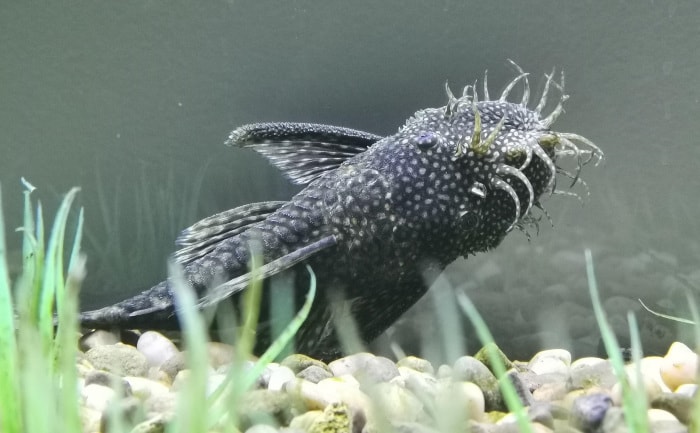
| Maximum Body Size: | overall species size is between 3 and 6 inches (7.6 to 15.25 cm) but there are many sub-species that don’t grow more than 4 inches or around 10 cm |
| Minimum Tank Size: | 30 gallons for the largest Bristlenose species |
| Suggested Water Temperature: | 65 to 80 °F (between 18 and 26 °C) |
| Key Traits: | Unique-looking tentacles on its mouth; eats a lot and makes more mess; relatively peaceful; prefers well-oxygenated water |
| Suitable for Beginners: | Depends on the species, as there are more than 60 |
Ancistrus spp is a genus of catfish belonging to the native of South America, particularly the Amazon River basin and its tributaries. Within this genus, there are several species commonly referred to as Bristlenose Plecos, including Ancistrus cirrhosus and Ancistrus temminckii.
Ancistrus cirrhosus – commonly called bristlenose pleco size is between 3 inch to 5 inches, but there are cases where a well-kept specimen has reached almost 6 inches.
However, in this section, I’d like to point the spotlight at two somewhat exotic fish species of the Ancistrus genus.
The first one is called the Gold Marble Bristlenose Catfish, also known as Ancistrus claro.
An adult Gold Marble Bristlenose Catfish reaches no more than 2.7 inches in full body length. This type of dwarf pleco fish is one of the smallest known Bristlenose pleco species.
Bristlenose pleco profile is nocturnal by nature and is most active during the night. During the day, they may spend much of their time hiding in caves or among driftwood.
The Gold Marble Bristlenose pleco tank size can be kept in a standard 15-gallon tank with a bottom footprint of 24.5 x 12.5 inches, but a 10-gallon tank is not out of the question.
The care level for Bristlenose plecos is generally considered to be easy, making them an ideal option for aquarists of all experience levels, including beginners. These fish are hardy and versatile, capable of flourishing in a variety of aquarium environments with little effort.
This fish prefers waters with a strong stream, which makes it an ideal choice for a river biotope aquarium.
These fish have a flattened body covered in bony plates, with a prominent, tentacle-like growth known as “bristles” on their snouts. Males bristlenose have more prominent filaments than the female bristlenose pleco which function for a range of reasons such as facilitating the sensory perception and exhibiting territorial dominance.
Keeping the right water temperature is essential for the health and well-being of Bristlenose Plecos. These fish prefer the temperature that varies between 65 to 80 degrees Fahrenheit, this can be accomplished with the use of a reliable aquarium heater.
Bristlenose plecos usually like an aquarium that has a slightly acidic to neutral pH range. Ideally, the pH level for Bristlenose plecos should be maintained between PH 6.5 and 7.5.
The Gold Marble Bristlenose catfish is not that territorial with similar-looking fish and will tolerate other peaceful bottom dwellers in larger tanks.
With proper care, Bristlenose Plecos lifespan is up to 10 years or more in captivity. Regular water changes, a balanced diet, and a stress-free environment are crucial for ensuring their longevity.
Bristlenose Plecos come in a variety of colors and patterns, ranging from solid black or brown to mottled or spotted variations.
Bristlenose plecos are mainly herbivorous, with a diet consisting largely of algae and plant matter. In the home aquarium, they play a beneficial role in controlling algae growth, contributing to the up keeping the tank hygienic and balanced environment. However, it’s essential to supplement their diet with additional sources of nutrition to guarantee optimal health and growth.
Having hiding spaces in the tank is essential for these fish as they sometimes like a little privacy.
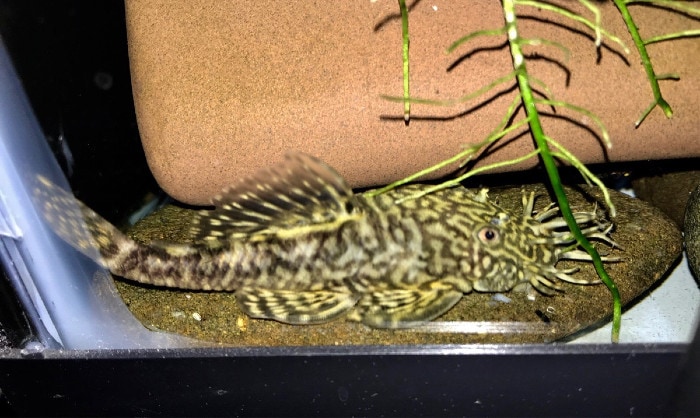
Anyway, there’s one other type of Bristlenose pleco from the Ancistrus genus that stays relatively small in its adult years.
One of the major factors of why Bristlenose plecos are favored by beginner aquarists is their small size. Compared to other pleco species, such as the common Plecostomus (Hypostomus plecostomus), as mentioned above Bristlenose pleco size remains relatively compact, usually reaching a length of around 3 to 6 inches in length.
Also recognized as Ancistrus dolichopterus or L183, is an exotic-looking suckerfish the bristlenose pleco size is up to 4.5 inches.
A single Starlight Bristlenose pleco tank size is around 20-gallon tank, but 30 or 40-gallon Breeder tanks are preferred since they have the same bottom footprint.
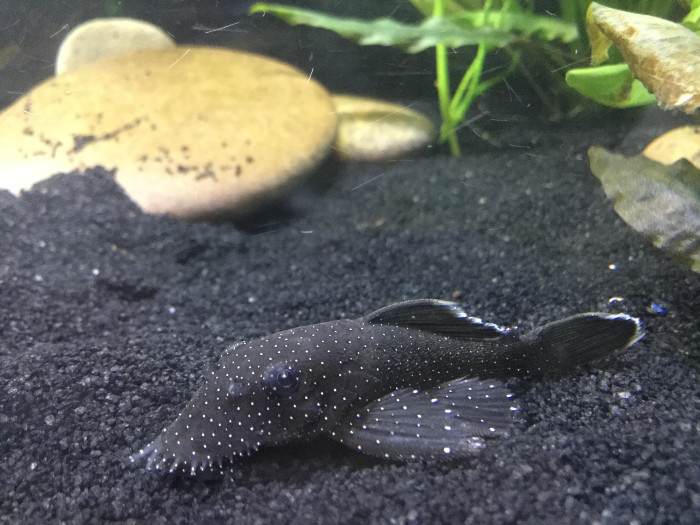
Anyhow, aside from looking super cool, this fish is also fairly expensive and can be sold for up to 40 dollars in some online fish stores.
Compared to male bristlenose plecos, female Bristlenose Plecos can be distinguished by their shorter bristles. Moreover, mature females may develop a fuller body shape, especially when carrying eggs.
However, it’s not the price that you should pay attention to, but rather the water requirements of this pleco species.
Starlight Bristlenose plecos prefer to live in “blackwater” aquariums.
This means that the tank should have soft, acidic water with high levels of dissolved tannins. Tannins are usually released in the water by organic sources such as peat, degrading leaves, or driftwood.
The tank mates of this type of pleco should also be fish that thrive in blackwater, such as the Chili Rasbora.
Maintaining this type of fish tank can be a challenge for a beginner, so keep that in mind if you want a Starlight Bristlenose pleco but you’re new to the hobby.
3. Dwarf snowball pleco – Hypancistrus sp. L471
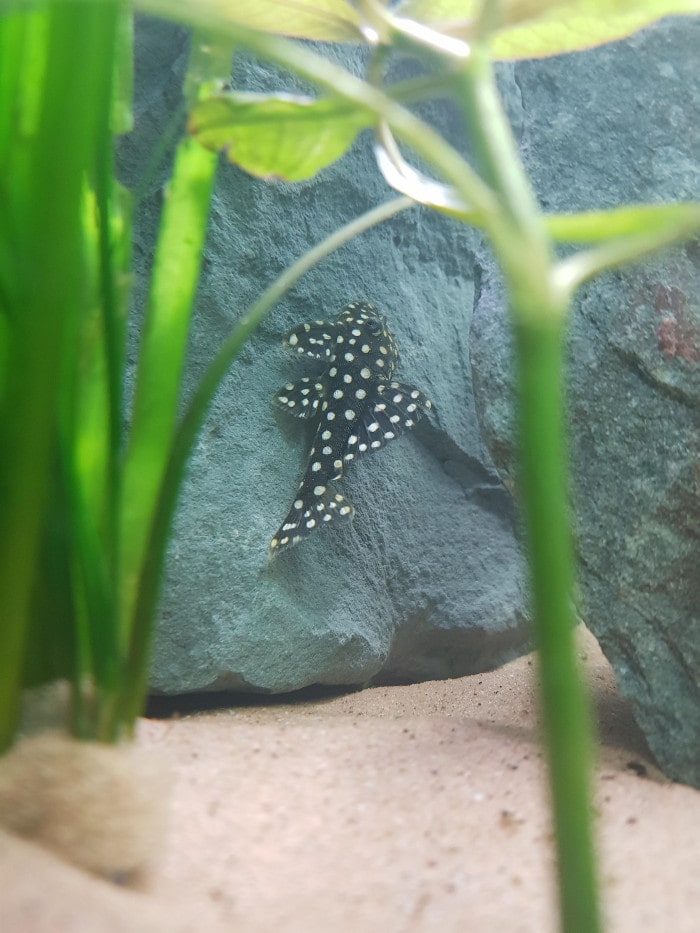
| Maximum Body Size: | 2.4 inches or just about 6 cm |
| Minimum Tank Size: | 10 gallons |
| Suggested Water Temperature: | 77 to 84 °F which equals 25 to 28.8 °C |
| Key Traits: | Is mostly carnivore; will actively scavenge the bottom at night; ideal for a small planted tank thanks to its diet; peaceful |
| Suitable for Beginners: | Not for complete beginners, but aquarists with general knowledge in the hobby can manage it |
The Dwarf Snowball Pleco finds its roots in the rocky riverbeds and crevices of the Rio Xingu, nestled within the heart of Brazil. This species, classified within the Hypancistrus genus, is widely recognized for its intricate patterns and vivid colors.
The Dwarf Snowball Pleco is easily distinguished by its base coloration of creamy white, adorned with exquisite black markings reminiscent of delicate snowflakes.
The Dwarf Snowball Pleco remains small in its adult life, reaching no more than 2.4 inches of full body length. The Dwarf Snowball Pleco is a little but impressive within the world of plecos. Despite its small size, it holds all the defining characteristics of its larger relatives, including a flattened body, sucker mouth, and distinctive dorsal and pectoral fins.
The Dwarf Snowball Pleco predominantly have a carnivorous diet. Within its native environment it sustains itself by preying on small invertebrates, crustaceans, and organic detritus that are found on the rocky substrate. Therefore, a diet rich in protein is important to fulfill its nutritional needs in captivity.
Dwarf snowball pleco care is essential to ensure longevity and well-being. Frequent water changes, careful monitoring of water parameters, and a well-balanced diet are vital components of their care routine. With proper attention, the dwarf plecos’ lifespan is up to 10 years or more in captivity, rewarding aquarists with years of joy and companionship.
The Dwarf Snowball Pleco flourishes in warmer temperatures. It has a preference of temperatures ranging from 77 to 84 degrees Fahrenheit (25 to 29 degrees Celsius). Furthermore, maintaining stable water conditions and a pH level between 6.5 and 7.5 is crucial for its health and well-being.
Being so tiny classifies this fish as one of the smallest pleco fish species in the aquarium trade to date.
For this reason, if it is the only bottom dweller in the aquarium, a Dwarf Snowball Pleco could live in a 10-gallon tank that has a good amount of plants, rocks, and some wood.
Of course, 10 gallons is the bare minimum and I’d usually recommend going with a 15-gallon for this pleco breed.
Anyway, this pleco breed is so unusual because it prefers warmer waters, and also, though still an omnivore, leans on the carnivorous side.
Both of these traits are rare among the smaller suckermouth catfish found in home aquariums.
On the other hand, these qualities make the Dwarf Snowball Pleco a worthy candidate for a heavily planted tank with peaceful, community fish that enjoy tropical waters.
Also, the Dwarf Snowball Pleco likes moderate water flow, so do keep that in mind when choosing your aquarium filter.
Anyhow, another thing to remember when looking after these dwarf fish is that they WILL go after shrimplets and smaller shrimp if given the opportunity.
4. Rubber Lipped Pleco – Chaetostoma formosae
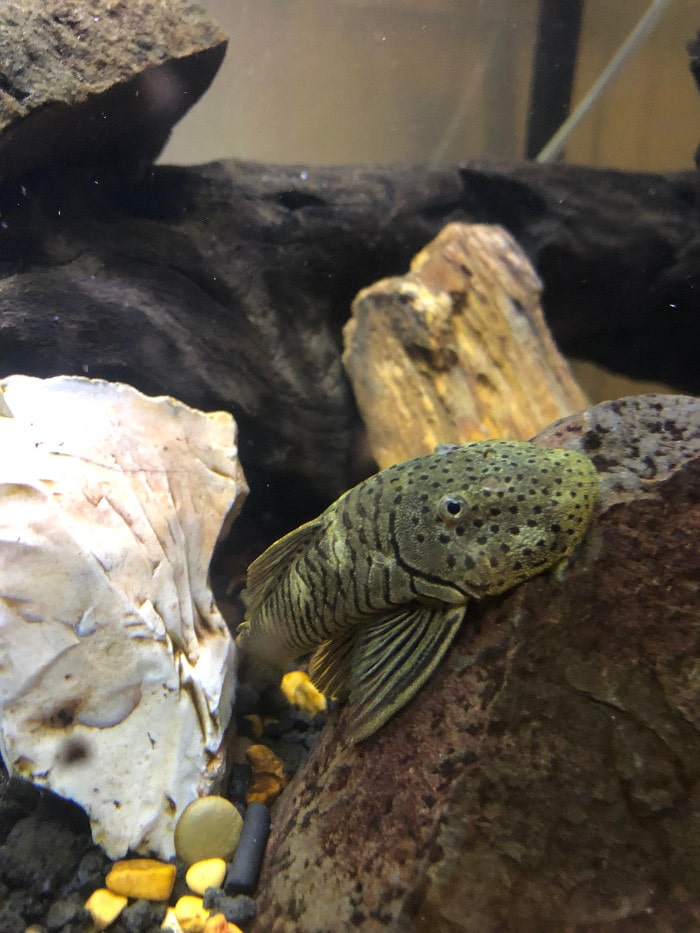
| Maximum Body Size: | 4.2 inches (10.6 cm). Some specimens can reach 4.5″ (11.4 cm) but that is very rare |
| Minimum Tank Size: | 20 gallons |
| Suggested Water Temperature: | between 71 and 78 °F (between 21.6 and 25.5 °C) |
| Key Traits: | Very peaceful; efficient algae eater; eats even Black Beard Algae |
| Suitable for Beginners: | Yes |
Hailing from the rivers and streams of South America, the Rubber Lipped Pleco is a member of the Chaetostoma genus, known for its peaceful nature. The term “formosae” is used to describe the species’ attractive physical appearance which includes distinctive markings and a strong build. With its flattened body, sucker mouth, and rows of bristles, this pleco species exhibits all the characteristic traits of its genus.
The Rubber Lip Pleco usually exhibits a mottled pattern of dark spots or stripes on a light brown to olive-green background, which serves as effective camouflage in its natural surroundings. As for size, adults can attain a length of up to 5 to 7 inches, making them a suitable addition to larger aquarium setups.
One of the Rubber Lipped Pleco’s most effective qualities is its big appetite for algae. These plecos play a necessary role in maintaining a hygienic and balanced aquarium environment as they feed on algae growth that accumulates on surfaces and decorations.
With its maximum body size of just over 4 inches, the Rubber Lip pleco tank size is around 20-gallon Long tank. That’s 30.25 x 12.5 inches of bottom footprint for a single specimen.
While Rubber Lipped Plecos can adjust in different tank sizes, they thrive best in larger aquariums that offer more space for exploration and grazing. A tank size of at least 30 gallons is recommended to accommodate their size and provide ample room for swimming and grazing activities.
Establishing an appropriate habitat is crucial for their ideal care level. A well-aerated aquarium maintaining stable water conditions, entailing a pH level between 6.5 and 7.5 and temperatures ranging from 72 to 78 degrees Fahrenheit (22 to 25 degrees Celsius), is crucial for their health and vitality.
The spotted rubber Lipped Pleco is very active when it forages for food and so needs more horizontal swimming space.
Rubber Lipped Plecos are omnivorous but with a heavily herbivorous diet, consisting mainly of algae and plant matter. In the home aquarium, they can be supplemented with algae wafers, blanched vegetables such as zucchini and cucumber, and sinking pellets to ensure sufficient nutrition.
They also hang out on the glass and other surfaces when they settle and accept the tank as their own.
One cool thing about this pleco is that it is one of the best freshwater algae eaters in the aquarium hobby.
Rubber Lipped Plecos eat all types of hair algae at astonishing rates, and can even get your tank rid of the dreaded Black Beard Algae.
Anyway, this tiny pleco is also quite peaceful and the only time you may see it get aggressive is in territory disputes with similar-looking catfish.
The care level for Rubber Lip Plecos is considered moderate, which means they require close monitoring of water quality, diet, and tank conditions. With proper care, the rubber lipped pleco lifespan is 10 to 12 years in captivity, rewarding aquarists with their algae-eating prowess and peaceful presence.
Other than that, it will not bother its tank mates.
Taking care of a Rubber Lipped Pleco can be very easy. Their low maintenance makes these fish a good beginner-friendly option.
5. Blue Panaque – Baryancistrus beggini L239
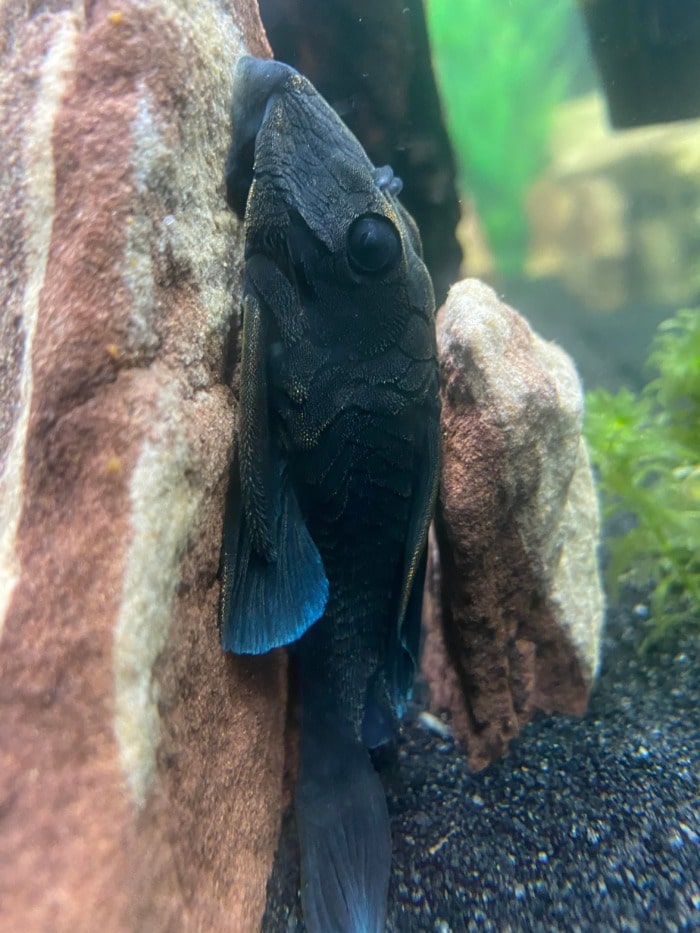
| Maximum Body Size: | 3.5 inches or just about 9 cm |
| Minimum Tank Size: | 20-gallon tank Long for a single specimen with no other plecos, and possibly bottom dwellers |
| Suggested Water Temperature: | 73.4 to 84 °F (between 23 and 29 °C) |
| Key Traits: | Very rewarding to keep; territorial and aggressive against its kind; active; impressive looks; diverse menu leaning to the herbivorous side |
| Suitable for Beginners: | No, this fish is delicate and it could perish even with seemingly perfect acclimatization |
Hailing from the Rio Orinoco in Venezuela, the Blue Panaque is a member of the Baryancistrus genus. This genus is known for its striking colors and unique characteristics. Distinguished by its robust build, flattened body, and prominent dorsal and pectoral fins.
The Blue Panaque pleco size reaches between 3.2 and 3.5 inches (8.1 to 8.9 cm). However, they require a spacious living terrain in a tank because they’re territorial and pretty active.
Due to its size and territorial nature, the Blue Panaque requires a spacious aquarium with plenty of room to explore and establish territories. A tank size of at least 20 for a single species and for larger numbers 75 gallons or more is recommended to accommodate its size and behavior.
Furthermore, maintaining temperatures between 75- and 82-degrees Fahrenheit (24 to 28 degrees Celsius) replicates the warm, tropical conditions of its natural habitat.
As its name suggests, the Blue Panaque differentiates itself by mesmerizing blue coloration from other pleco species. The iridescent blue hues shimmer against a backdrop of darker markings, forming a visually captivating scene.
The L239 Blue Panaque pleco is not actually a true Panaque sp and the two species do differ quite a lot.
The care level for the Blue Panaque is considered moderate, requiring regular monitoring of water quality, diet, and tank conditions. Under optimal care level the blue panaque lifespan can live for a duration of 8 years in captivity.
The Blue Panaque thrives in blackwater environments characteristic of its native habitat in the Rio Orinoco. The Blue Panaque prefers soft and acidic water since they come from blackwater environments.
Some users keep them in neutral pH (7.0), but I’ve found that this pleco does best between 6.5 and 6.0 pH.
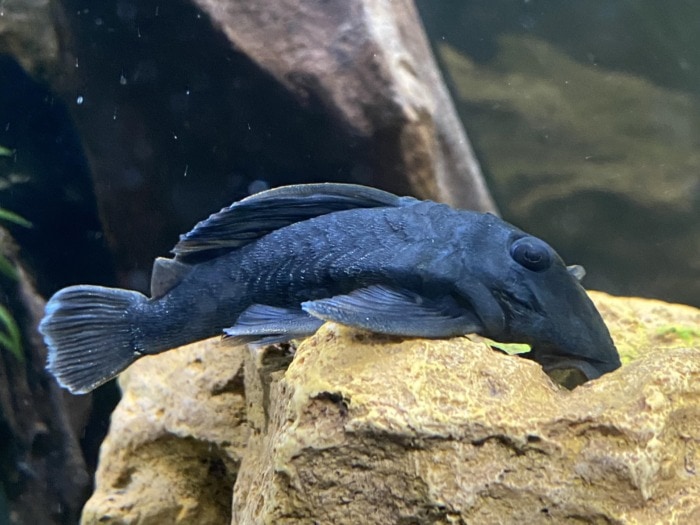
Anyway, the Blue Panaque pleco is an omnivore, but from my experience, they are predominantly herbivorous.
What I find weird about these fish is that they get picky about vegetables.
Most herbivorous fish we’re used to keeping would snack on pretty much any vegetable, but not the Blue Panaque.
I’ve confirmed with others who keep this fish that it will rarely, if at all, accept carrots and the regular greens.
Blue Panaque plecos actually prefer more “unusual” veggies in their diet such as potatoes… Also, you should likely offer fruit too.
Author’s note: Although heavily leaning on the herbivorous diet, the Blue Panaque pleco does require meaty foods from time to time. Fortunately, they are not as picky about their meat. Blue Panaque plecos will readily accept most frozen foods.
6. Angelicus Pleco – Hypancistrus sp. L136
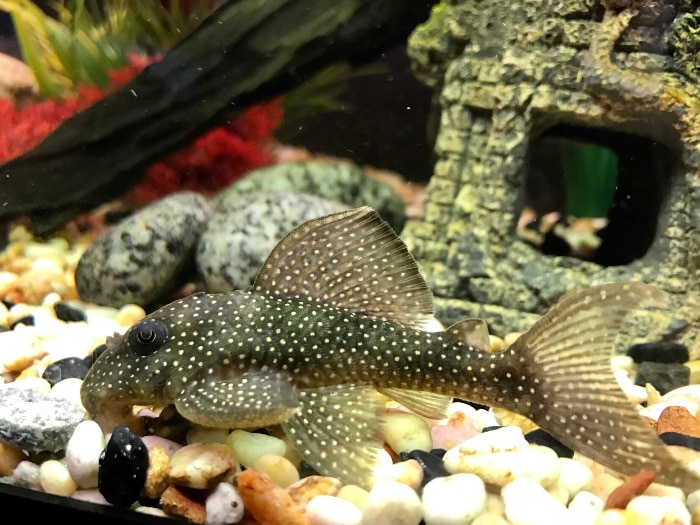
| Maximum Body Size: | 3.1 inches or 7.9 cm |
| Minimum Tank Size: | 20-gallon tank |
| Suggested Water Temperature: | 73 to 82 °F which equals 22.7 to 27.7 °C |
| Key Traits: | May become aggressive towards other Hypancistrus species; prefers meat as a staple diet; likes moving water with high oxygen levels |
| Suitable for Beginners: | Yes, as long as the aquarist is ready to provide the needed conditions and stays on top of water maintenance |
This pleco species which originates from Rio Xingu in Brazil has become famous among aquarists for its remarkable appearance and intriguing behavior.
The Angelicus Pleco is a visually stunning fish characterized by its unique pattern and brilliant colors. Adorned with bold, black markings set against a backdrop of creamy white or golden hues, this pleco exudes an air of elegance and sophistication.
Although the Angelicus Pleco is normally friendly with members of its own kind, it can display territorial behavior and aggression towards other bottom-dwelling fish species. It’s essential to provide sufficient hiding spots and territories within the aquarium to prevent conflicts.
A beautiful fish species, from the Armored catfish family, the Angelicus pleco size is no more than 3.1 inches.
Thanks to its rather small size, this fish can be kept in a tank that is at least 24 inches horizontal length and 12 inches wide.
The smallest tanks that correspond to these measurements are the standard 15-gallon and the 20-gallon tall tank.
Constructing appropriate habitats is important for the health and welfare of the Angelicus pleco.
A large aquarium with abundant hiding spots and suitable decor is ideal for welcoming these plecos. Rocks, driftwood, caves, and plants provide essential shelter and territories for them to thrive.
The care level for the Angelicus Pleco is moderate. Although not very difficult to care for but has some specific requirements that must be fulfilled to guarantee its vitality.
The Angelicus Pleco will appreciate a fish tank with medium to high water current, driftwood decorations, and round stones.
The water in your freshwater aquarium should have minimal pollution, and even higher levels of Nitrate will not be tolerated well.
The Angelicus Pleco lives in warm, tropical waters resembling its native Brazilian habitat. It prefers temperatures ranging from 78 to 82 degrees Fahrenheit (25 to 28 degrees Celsius).
A pH level should be between 6.5 and 7.5 to promote health and well-being.
The Angelicus pleco lifespan 5-8 years or more in captivity, rewarding aquarists with years of enjoyment and companionship.
Also, when keeping these plecos in your tank, make sure to have at least one air stone for good water oxygenation.
The Angelicus Pleco is predominantly carnivorous, preferring meat-based diets over plant matter.
So, make sure that you’re feeding your Angelicus Pleco. Most of their diet consist of meat like Daphnia and Bloodworm, whereas vegetables should only be offered occasionally.
7. Pitbull Pleco – Parotocinclus jumbo
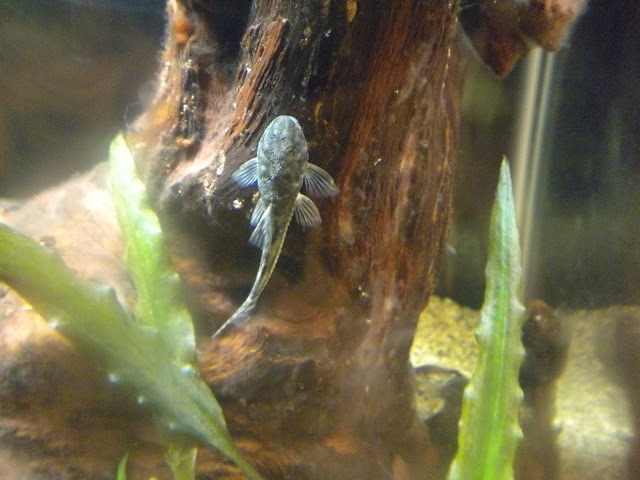
| Maximum Body Size: | 2.4 inches, but usually stay around 2 (5 to 6 cm) |
| Minimum Tank Size: | 30-gallon Breeder for a group of 6 |
| Suggested Water Temperature: | 68 to 79 °F (20 to 26.1 °C) |
| Key Traits: | prefers staying in groups; eats algae, but you should not rely on them to clean your tank; peaceful; is pretty active when settled; peaceful |
| Suitable for Beginners: | No, these fish are a little more fragile during acclimatization, in which stable water parameters are required |
The Pitbull Pleco specifically belongs to the river systems of South America, particularly the Amazon basin and its tributaries. Belonging to the Parotocinclus genus, this species is distinguished by its streamlined, elongated body, adorned with rows of bony plates and a distinctive sucker mouth.
Its coloration can vary, ranging from shades of brown to olive-green, providing effective camouflage in its natural habitat.
The Pitbull pleco care is relatively low, which makes it accurate for novice aquarists. They are hardy and adaptable fish that can thrive in a wide range of water conditions.
Pitbull Plecos’ lifespan can be up to 15 years in captivity.
If you’re looking for a pleco that stays very small, then consider getting a Pitbull Pleco. This fish reaches no more than 2.4 inches upon maturity and is usually a slow grower.
What you should know about the Pitbull Plecos is that they are social and need to be in groups of at least 3, but if you have the needed space – go with 6 or more.
A standard 15-gallon tank should be the minimum if you want to keep 3 Pitbull Plecos, in case the unlikely happens and each of them grows to 2.4 inches.
A standard 30-gallon Breeder tank is recommended if you’d like to keep 6 of these small fish.
Make sure the aquarium is well-aerated and is furnished with plenty of hiding spots, such as caves, driftwood, and plants, to copy their natural habitat. The substrate in the tank should not be anything sharp, and preferably sand.
Pitbull Plecos thrive in tropical temperatures ranging from 68 to 79 degrees Fahrenheit with preference of slightly acidic to neutral water with a pH level between 6.5 and 7.5.
The Pitbull Pleco will try to bury itself in the substrate if it feels that something is not right.
Aside from that, these small plecos are very active once settled, but prefer to stay on the bottom of the fish tank.
Anyway, Pitbull Plecos are omnivorous. In their natural habitat they enjoy a vegetarian diet, accepting the occasional animal protein.
Though Pitbull Pleco will eat surface algae, it will not be a very efficient algae eater overall.
The live plants in a planted tank will not be eaten.
Author’s note: Due to obvious differences to other Parotocinclus species, the discoverers of the Pitbull Pleco believe that it should be moved to a different genus.
8. Queen Arabesque Pleco – Hypancistrus sp. L260
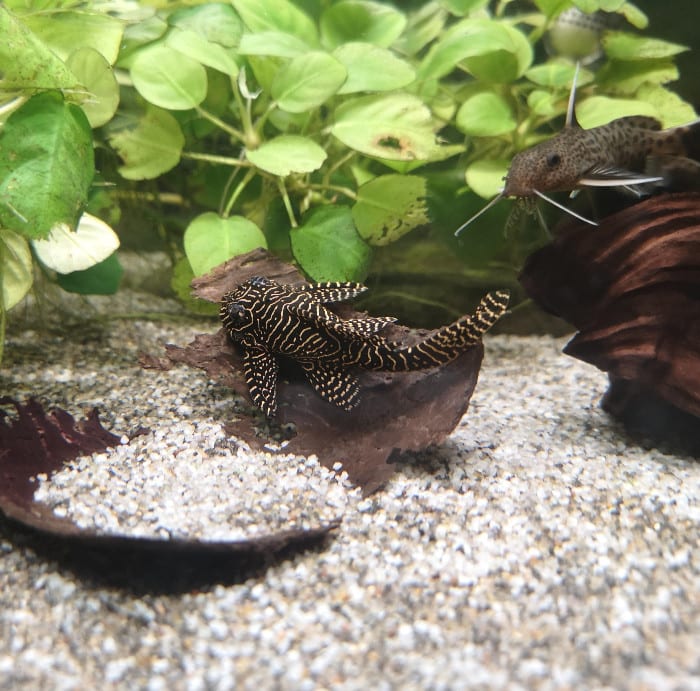
| Maximum Body Size: | 3.5 inches (8.9 cm) |
| Minimum Tank Size: | Any tank with a horizontal length of 24 inches (e.g. a 15-gallon tank) |
| Suggested Water Temperature: | between 73 and 84 °F (22.7 to 29 °C) |
| Key Traits: | Doesn’t like the company of fast swimmers or aggressive fish; 100% carnivorous and won’t touch algae with a stick; loves caves more than other plecos; minds its own business |
| Suitable for Beginners: | Yes, as long as the aquarist chooses tank mates carefully and is willing to provide quality food to the fish |
The Pleco Queen Arabesque is native to the Rio Xingu basin in Brazil, where it lives in rocky river beds that are decorated with caves and crevices. The species is classified within the Hypancistrus genus, distinguished by its intricate black and white patterning like zebra-pattern.
Caves are their preferred habitat due to their nocturnal nature and secretive behavior. By providing an ample section of caves and hiding spots replicates their natural environment, allowing them to exhibit their instinctual behaviors and feel secure within the aquarium.
The Queen Arabesque pleco size is small, an exotic fish that grows to just about 3.5 inches upon good care. As a rule of thumb for minimum tank size, you can keep a single specimen in a standard 15-gallon tank, or any of the 20-gallon varieties.
Anyway, this fish doesn’t need the company of its own kind and it will not bother its tank mates.
Regarding lifespan, with proper care and maintenance, the Queen Arabesque Pleco lifespan is up to 10 to 15 years, providing enthusiasts with years of companionship and admiration.
Regarding the care level these species are classified under moderate category. While they don’t require excessive attention, maintaining optimal water parameters and providing necessary nutrition for their well-being.
The Pleco Queen Arabesque is, in fact, so peaceful that it may be outcompeted for food if the other fish in the tank are more aggressive feeders.
In order to accurately mimic the environment, the aquarists should design an aquarium with rocky river beds with ample hiding spots and caves. The inclusion of driftwood, rocks, and caves provides essential shelter for the Queen Arabesque Pleco, allowing them to retreat and feel secure.
Stability in water parameters is vital for their care level and Queen Arabesque pleco lifespan. The ideal pH range for these plecos falls between 6 to 7.5, while temperatures should be kept between 73°F to 84°F.
What’s interesting about this breed is that they do not accept veggies at all.
Their diet should be 100% composed of small invertebrates. Requiring a protein-rich diet to thrive. Their diet primarily consists of meaty foods such as bloodworms,
As with all other plecos on this list, the Queen Arabesque Pleco likes some driftwood in its aquarium, but more importantly – it LOVES having its own cave.
Given how beautiful this pleco is and its carnivorous nature, it’s the perfect candidate for a planted aquarium with a medium water current.
9. Clown Pleco – Panaqolus sp. L206
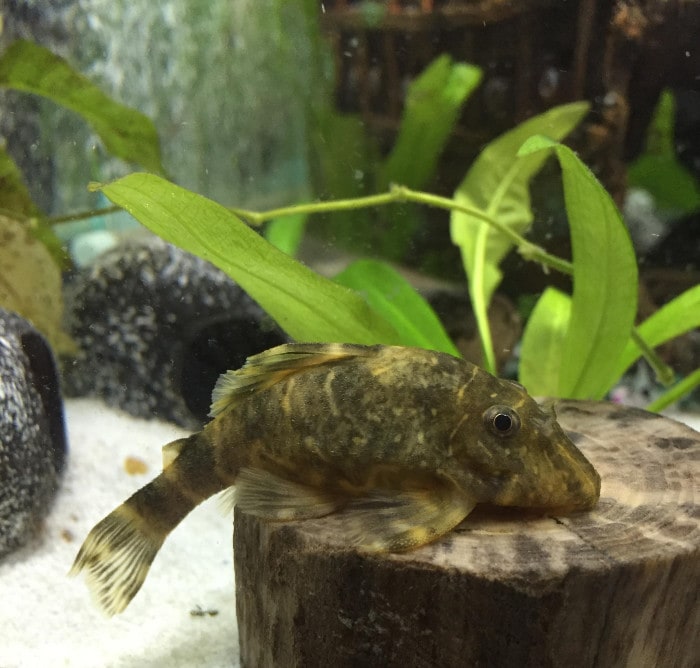
| Maximum Body Size: | 3.1 inches (7.9 cm) |
| Minimum Tank Size: | The fish is not very active, so a 10-gallon tank is appropriate |
| Suggested Water Temperature: | 77 to 85 °F or 25 to 29.4 °C |
| Key Traits: | Eats and constantly chews on wood; won’t really clean algae; quite peaceful; destroys live plants |
| Suitable for Beginners: | Yes, this species is easily manageable as long as research on the lifestyle of the fish has been done |
Originating from the Amazon Basin and its tributaries like the Ucayali and Maranon in Peru, the Clown Pleco finds its habitat amidst rocky riverbeds and areas with thick vegetation. This species belongs to the Loricariidae family, renowned for its armored catfishes.
Note that this is not Panaqolus maccus, but another small species recognized under the same nickname.
Clown Plecos are identified by their distinctive behavior of wood-eating habits. In their natural territory, these plecos consume wood debris and detritus, utilizing specialized bacteria in their digestive system to break down cellulose.
In the aquarium setting, providing driftwood is essential to meet their dietary needs and promote natural behaviors.
Clown pleco are known for their gentle nature and are well-suited inhabitants for community aquariums. They coexist sweetly with a variety of tank mates, including smaller fish species, provided they share similar temperaments and habitat requirements.
The only serious difference between the two is that the P. maccus reaches 3.5 inches in maximum size, whereas the L206 Clown Pleco grows to no more than 3.1 inches.
When considering housing Clown Plecos in smaller tanks, it’s crucial to provide adequate space for their comfort and health. Pleco does not require a lot of personal space and given that you structure the tank with a lot of hiding places, you can safely keep 2 specimens in a 20-gallon long tank.
Clown Plecos’ wood-eating habits, driftwood serves as both a dietary staple and a natural hiding spot. Choose sturdy pieces of driftwood that won’t deteriorate quickly and provide enough surface area for grazing.
Incorporate caves, PVC pipes, or ceramic decorations to offer hiding spots and shelter for Clown Plecos.
The clown pleco temperature ranges from 77°F to 85°F and slightly acidic too little above neutral pH levels between 7 to 8.
One of the most frequently asked queries among enthusiasts is, “How big do Clown Plecos get?” Normally, these clown plecos’ size reaches 3 (7 to 10 centimeters) but a full grown clown pleco can reach up to 4 inches , making them a suitable choice for smaller tanks.
The clown pleco lifespan is usually around 10-12 years in captivity.
Feeds on wood and vegetables and the clown pleco diet does not need animal protein.
Having at least 2 types of driftwood in the aquarium is a must if you are to keep this species healthy.
The tangles and branches will be eaten with time and need occasional replacement.
Also, because of the wood, Clown Plecos will produce huge amounts of sawdust poop.
The sawdust won’t spike the Ammonia or Nitrite levels in the aquarium, but a decent mechanical filtration should be in place to take care of the particles.
For this reason, I’d recommend setting up a powerful HOB filter with some fine filter floss media in your Clown pleco tank.
Author’s note: A common misconception about the Clown Pleco is that it should eat algae since it’s a vegetarian. However, practice shows that this is not really the case. Therefore, if you’re looking for a small pleco that cleans algae you should look at the other entries on this list.
10. Zebra Pleco – Hypancistrus zebra
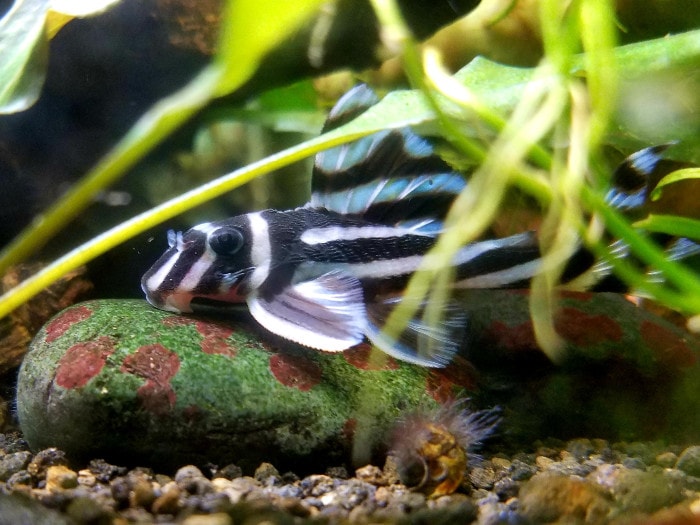
| Maximum Body Size: | up to 3.2 inches, but usually they stay around 3 (7.6 cm) |
| Minimum Tank Size: | A single specimen will do well in a 10-gallon tank with lots of crevices for hiding, but a 15-gallon one is likely better |
| Suggested Water Temperature: | between 78.8 and 86 °F (between 26 and 30 °C) |
| Key Traits: | requires high water temperature and good oxygenation; is not competitive when feeding, so avoid housing it with aggressive feeders; one of the most expensive freshwater fish |
| Suitable for Beginners: | No |
The Zebra pleco, which originates in the Rio Xingu basin of Brazil from the fast-flowing rivers flourishing in warm waters.
The Zebra Pleco, also known as Columbian zebra pleco, earns its name from the fascinating zebra-like stripes that enhance its streamlined black body. These striking patterns create a visually arresting contrast, making the Zebra Pleco a standout addition to any aquarium.
The Columbian zebra pleco, despite their remarkable physical traits, are relatively easy to care for as long as their requirements are addressed.
The exceptional Zebra Pleco size is around 3 inches but a full-grown zebra pleco can reach up to 3.7 inches. These fish like to hang out in crevices and are not active foragers, so a tank with a smaller bottom footprint, such as the 10-gallon one, will do.
Under optimal care level the pleco zebra lifespan is up to 10 years.
Nevertheless, a 15-gallon tank should provide you (not the fish) with more freedom to build multiple caves in the rocks and driftwood.
But due to their defensive nature and need for plenty of hiding spots, Zebra Plecos require a well-planned tank setup. A tank size 30 gallons is recommended to provide enough space for a pair or small group of Zebra Plecos.
This beautiful pleco prefers aquariums that simulate their natural biotope.
This would mean that a happy Zebra Pleco will live in a tank that has strong water movement, a sandy substrate, some driftwood, round stones, and high levels of dissolved oxygen.
There should be a lot of caves in between the rocks where the fish will spend their time. Zebra Plecos typically find shelter in rocky crevices and caves along the riverbed.
Another water parameter that should be strictly maintained is the rather high temperature.
Compared to many other tropical fish species, it prefers temperatures on the higher end of the spectrum. Making sure that the water temperatures are within the range of 78°F to 86°F (28°C to 30°C) is crucial to mimic their habitat and ensure to reach the care level they need in captivity.
Along with high temperatures, they prefer slightly acidic to neutral pH levels ranging from 6.5 to 7.2.
Unlike other types of plecos, the Zebra Pleco needs exceptionally high-water temperatures in order to stay healthy and live a long and fulfilling life.
Aside from that, Zebra Plecos is not picky about other water parameters.
This species is also predominantly carnivorous, and vegetables will rarely be taken by the fish. Require a varied diet to meet their nutritional needs. Offer a combination of high-quality sinking pellets, algae wafers.
Anyhow, before rushing to your local fish store in search of this gorgeous fish, know that the Zebra Pleco can get pretty expensive. Don’t say I did not warn you!
11. Leopard Frog Pleco – Peckoltia compta
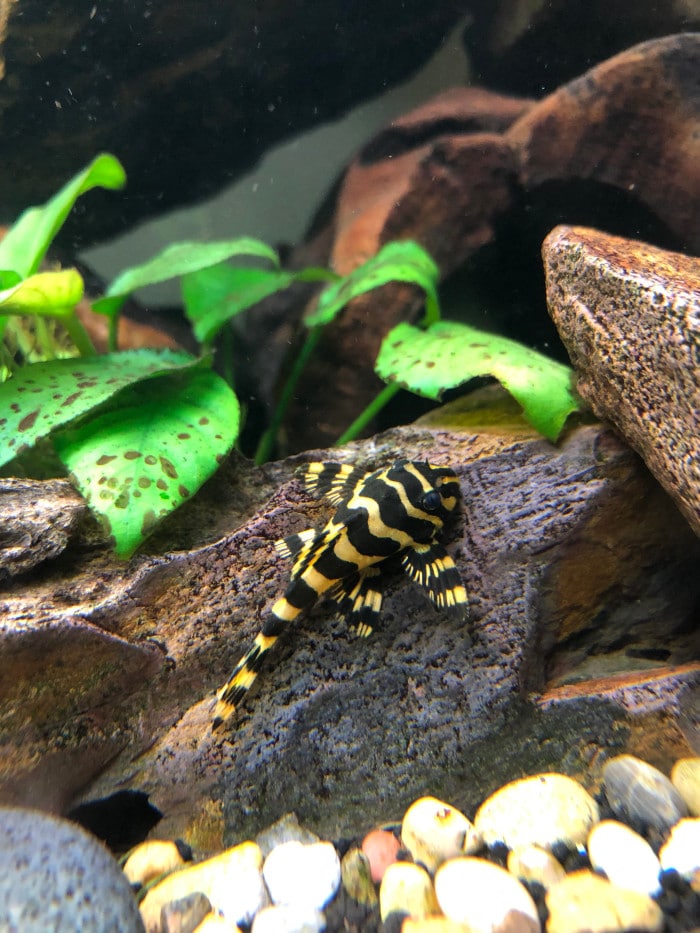
| Maximum Body Size: | up to 4.3 inches (nearing 11 cm) |
| Minimum Tank Size: | 10-gallon tank because this pleco is not very active |
| Suggested Water Temperature: | 75 to 86 °F or around 24 to 28 °C |
| Key Traits: | thrives in tropical water temperatures; peaceful to tank mates that do not look similar; expensive; is not a reliable algae eater |
| Suitable for Beginners: | No |
The Leopard frog pleco is indigenous to the tropical waterways of South America, specifically the amazon rivers regions. It primarily resides in shallow, slow-moving streams and tributaries rich in vegetation and submerged driftwood. This species belongs to the Loricariidae family, renowned for its armored catfishes, and is commonly found in Brazil, Peru, and Colombia.
Frog Pleco earns its name from the unique leopard-like spots that beautify its body, initiating a visually striking contrast against its dark base coloration. With its flattened body and intricate markings, this species epitomizes elegance and charm, thereby increasing the natural beauty to any aquarium.
Aside from its stunning appearance, the Leopard Frog Pleco is cherished by many fish keepers for retaining a small size throughout its lifespan. Full size leopard frog pleco can reach a maximum of 4.3 inches, but most specimens will remain at three and a half.
Leopard Frog plecos are not very active but are rather territorial among each other, and some species of shark-like fish.
One of the most pleasing characteristics of the Leopard Frog Pleco is its peaceful nature. Unlike some more aggressive species, this pleco tends to be docile and non-confrontational, making it an excellent choice for community aquariums. Its calm temperament allows it to coexist harmoniously with a wide variety of tank mates, including small to medium-sized fish species.
For this reason, a suitable tank size for a single specimen would be the 20-gallon tank, but a 10-gallon one with good decoration would also be acceptable (and not pushing it).
Anyway, the Leopard Frog Pleco thrives in waters with The Leopard Frog Pleco (Peckoltia compta) typically prefers tropical water temperatures within the range of 75°F to 86°F (24°C to 28°C) along with a pH of between 5 and 7, which means that aquariums with softer water will be preferred.
Another important water parameter for this pleco species is temperature.
Leopard Frog Plecos are omnivorous and require a varied diet to meet their nutritional needs.
Leopard Frog Plecos enjoy tropical waters and, in colder environments will be prone to disease and parasites such as freshwater Ich which can be difficult to treat.
For this reason, if kept in smaller fish tanks, having a powerful but small water heater is a must for this species.
Its care level is considered moderate, requiring consistent water quality, appropriate tank conditions, and a balanced diet to thrive. With optimal care, Leopard Frog Plecos lifespan is up to 10 to 15 years, providing enthusiasts with years of enjoyment and companionship.
Anyhow, note that the Leopard Frog Pleco may not be as expensive as the Zebra Pleco but it may still reach more than a hundred dollars in some aquarium fish stores.
12. Brown Dot Pleco (L006) – Peckoltia oligospila
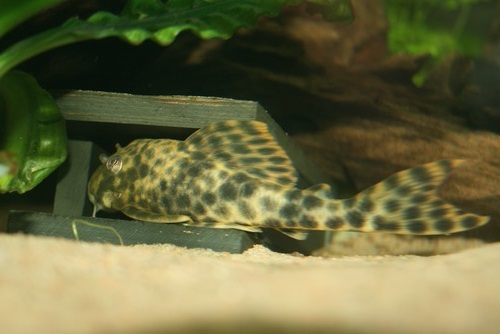
| Maximum Body Size: | 3.9 inches (10 cm) |
| Minimum Tank Size: | 40 gallons because this pleco likes to have more space |
| Suggested Water Temperature: | 75 to 86 °F (between 24 and 30 °C) |
| Key Traits: | Generally peaceful, but can be territorial at times |
| Suitable for Beginners: | Yes |
They are indigenous to the Amazon Basin, especially the tributaries and riverine areas of Brazil and Peru. They occur in environments rich with vegetation and submerged driftwood. This species belongs to the Loricariidae family, known for its armored catfishes, and is commonly found in shallow, slow-moving streams with sandy or rocky substrates.
The Brown Dot Pleco possess distinguishing traits making them different from other species , they have a brown body embellished with distinct and dispersed dots and delicate patterns . It widened body sucker like mouth make them to feed on algae and other organic food
The Brown Dot Pleco (Peckoltia oligospila) typically reaches no more than 3.9 inches in length.
Moderate care level should be maintained for the Brown Dot Pleco, which can be easily achievable for average aquarists, making it growable for all. A well-equipped aquarium containing ample space for moving, hiding, and mating and an appropriate tank environment may elevate the longevity of pleco.
The brown dot pleco lifespan is about 10 to 15 years, contingent on tank conditions and maintenance.
They are well known for their peaceful demeanor, and the Brown Dot Pleco is an ideal addition to community aquariums. They can prefer to coexist with other tank animals, like fish species and other mates. Its docile nature and non-aggressive behavior make it a popular choice among aquarists seeking a tranquil aquatic environment.
As the name suggests, its body is covered in tiny brown dots, which are more pronounced in the fins.
Even though the Brown Dot Pleco is well suited for beginners, this tiny pleco species is a bit rare to find.
In the wild, it’s typically found in the Tocantins and Capim rivers in north eastern Brazil.
A Brown Dot Pleco has an omnivorous diet and generally likes to eat mosquito larvae, bloodworms and Daphnia. A balanced diet should be provided for their overall health with sinking pellets, and blanched vegetables can promote optimal growth.
However, it will occasionally like to snack on some fresh fruits or vegetables so you can offer it boiled potatoes from time to time.
In terms of character, the Brown Dot Pleco is quite peaceful, but it can show its teeth if it doesn’t have enough free space.
They have a limited temperature range of 75 to 86°F , and because they are programmed to inhabit habitats of moderate temperature, temperature fluctuations may incur losses to the population of pleco. A tank size of at least 30 gallons is recommended to accommodate a single Brown Dot Pleco with ease. PH also has a remarkable impact on growth and ranges from 6.5 to 7.5.
Making a good-quality tank or aquarium guarantees a conducive environment for Brown Dot Pleco, as they are adapted to live in a habitat full of amenities for the pleco. Aquariums should be designed in such a manner that the pleco inhabits a natural habitat.
Making a fitting environment for Brown Dot Plecos includes incorporating driftwood, rocks, and caves to mimic their natural habitat.
That’s why you’ll need at least 40 gallons of water, despite the small size of this pleco.
13. Alenquer Tiger Pleco

Appearance and size | They have a mesmerizing appearance, young ones are small and adults reach up to 5 to 6 inches in length |
| Temperature requirement | Required temperature for growth is 78 to 82 degrees Fahrenheit or 25 to 28 degree Celsius. |
| Origin and habitat | Originated from the Rio Negro basin in Brazil, they can be grown in aquariums easily . |
| pH requirement | pH of the water should be maintained at 6.5 to 7.5 for proper progress. |
The Alenquer Tiger pleco, also known scientifically as panaque, belongs to the panaque genus. They originated basically from the Rio Negro basin in Brazil and offer breathtaking and attention-grabbing appearances for those possessing aesthetic sense and beauty-judging qualities.
They are native to the aquatic ecosystem of the Rio Megro basin in Brazil; they are rigorous, robust, and colorful, making them more attractive to enthusiasts of aquariums. They provide unique vitality to the environment, adding value to aquaculture.
The enriching feature of the Alenquer Tiger Pleco is its distinguishing coloration and intricate build and structure. Adorned with bold, black stripes set against a backdrop of rich, reddish-brown tones, this pleco shares similarities with the majestic tiger in its appearance.
The Alenquer tiger pleco size ranges from 5 to 6 inches. Despite its impressive appearance, the Alenquer Tiger Pleco remains relatively small, making it suitable for a wide range of aquarium setups.
They show a flexible diet disposition and nutritional pattern. They can get their nutrients from both meat and plant matter. While it may graze on algae and detritus, it primarily relies on protein-rich feeds such as bloodworms, brine shrimp, and vegetable matter. They feed on a wide range of feeding materials.
The Alenquer Tiger Pleco shows a special liking for warmer water thanks to its natural warmer habitat. They prefer temperatures ranging from 78 to 82 degrees Fahrenheit (25 to 28 degrees Celsius).
The aquarium should be spacious, and we’ll ventilate it in order to provide a flourishing environment for the pleco. A spacious aquarium with ample hiding spots and suitable decor is ideal for accommodating these plecos. Rocks, driftwood, caves, and plants provide essential shelter and territories for them to survive.
Proper care level must be carried out to maintain a conducive and favorable environment for the pleco, water quality should be good, aquarium conditions should be clean and fair, and proper feeding techniques. The Alenquer tiger’s lifespan is nearly 10 years in captivity.
Finally, it is advisable to provide suitable feed and surrounding conditions are favorable for the pleco. They stand as tantamount to the beauty and diversity of aquatic ecosystems. With their enthralling appearance, they make the environment stunning.
14. King Tiger Pleco

Scientific name | Hypancistrus sp. L333 |
| General characteristics | Alluring color pattern and stunning appearance, robust and vibrant build add value to their already prized position |
| Normal size | They vary in size from young to adult, young ones are small but adults can reach up to 4 or 5 inches in length |
| Origin and habitat | In Rio Xingu river in Brazil. |
The King Tiger pleco, also known scientifically as Hypancistrus sp. L.333, is one of the prized and valued freshwater species often raised by aquarium enthusiasts to elevate the status of their aquarium. Owing to their remarkable beauty and enchanting attractions.
The King Tiger pleco is native to Rio Xingu, a part of the Amazon River in Brazil. They elicit a unique response from those with an interest in aquaculture by igniting and sparking motivation to adapt and grow in aquariums. They are a good addition to the aquatic ecosystem of South America.
They have a robust and vibrant build and a unique pattern with coloration that gives them distinctive qualities.
They possess a distinguishing characteristic pattern with bold black stripes on the entire body against a vibrant yellow or orange, thus offering an intricate and stunning look for beauty lovers. They have an alluring and appealing body structure that serves as a source of attraction.
They vary greatly in size, with the adults ranging in size from 4 to 5 inches in length. Their size is highly suited for a moderate-range aquarium, making them a choice for many aquaculture growers. They have a stunning look and appearance.
They are programmed to avail themselves of numerous nutrient classes, ranging from meat inside the water habitat to plant matter. They eat detritus and algae in the watery environment.
They primarily rely on protein-rich foods such as bloodworms, shrimp, sinking pellets, other aquatic animals’ fungi, algae, and vegetable matter.
Good-quality feed containing the required nutrients is necessary for the proper growth and maintenance of pleco if raised in an aquarium.
They are inclined to survive in warm water habitats, as their natural habitat is warm. Their temperature range is from 78 to 82 degrees Fahrenheit (25 to 28 degrees Celsius).
Water quality and surrounding conditions should be maintained at a good for the existence of pleco, and a pH level between 6.5 and 7.5 is crucial for its well-being.
The aquarium should be maintained at par with the standard required for the Tiger King pleco, possessing all the requirements for pleco. Creating a suitable environment is crucial for the well-being of King Tiger Pleco. The size of the tank matters so it is crucial to consider its size while constituting the pleco, and should be spacious so that it can move freely without hindrance.
A high to moderate level of care is a must in order to maintain the Tiger King pleco in production and reproducing conditions. Apart from this, proper attention will be given to them, and dietary care and other amenities will be provided for them.
If proper care is taken, then the king tiger pleco lifespan is over ten years in captivity, aiding in the value of the aquarium for a definite period of time.
Feed containing all the nutrients necessary for the growth and betterment of pleco is provided with regularity. Protein-rich feed such as bloodworms and shrimp fish meal should be included in the diet.
It’s essential to monitor their feeding behavior and adjust their diet accordingly to maintain optimal health.
In the end, it is to advise that their environment be cleaned and flourishing for them. The King Tiger Pleco serves as a symbol of elegance and majesty in the freshwater aquarium hobby.
Owing to their remarkable and elegant appearance they can be a source of happiness and satisfaction for lovers. Proper feeding, good environmental conditions, and proper attention guarantee a highly producing Tiger King pleco population.
Are there even smaller pleco fish?
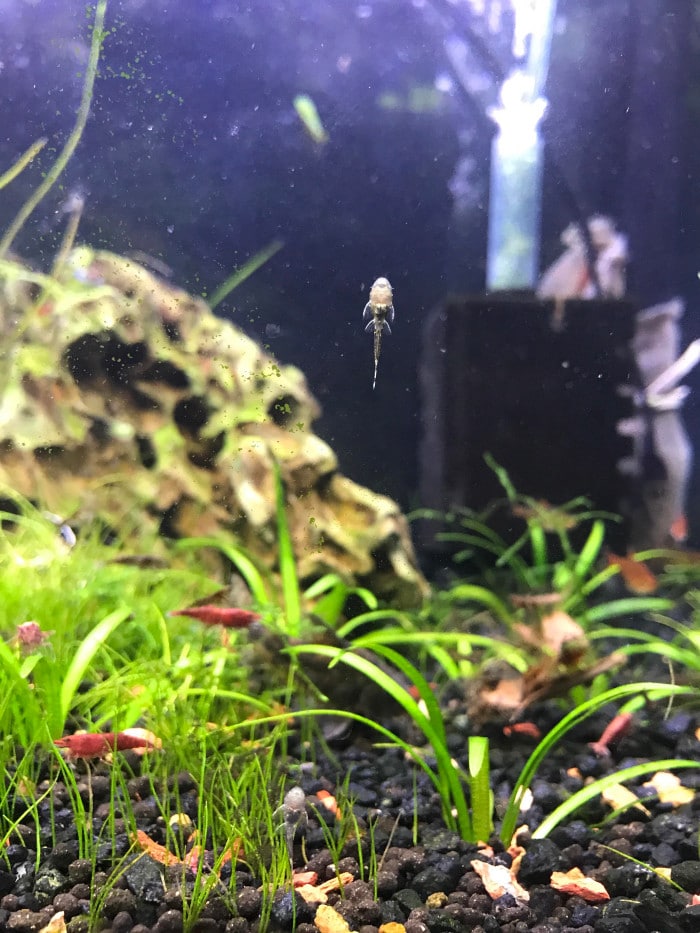
The smallest known pleco is the Soromon Pleco (Soromonichthys stearleyi), reaching a total body size of just 1.2 inches or precisely 3.05 cm.
However, there’s almost no information on this species, which means that it’s likely very rare and you won’t have a realistic chance of ever keeping one. It was first described in 2011 by scientists who discovered it in the Solomoni Creek of Venezuela.

Even over at Planet Catfish’s index, the information on this dwarf fish was scarce. For this reason, in my list above, I only mention pleco fish that, aside from staying small, are also available in the aquarium trade.
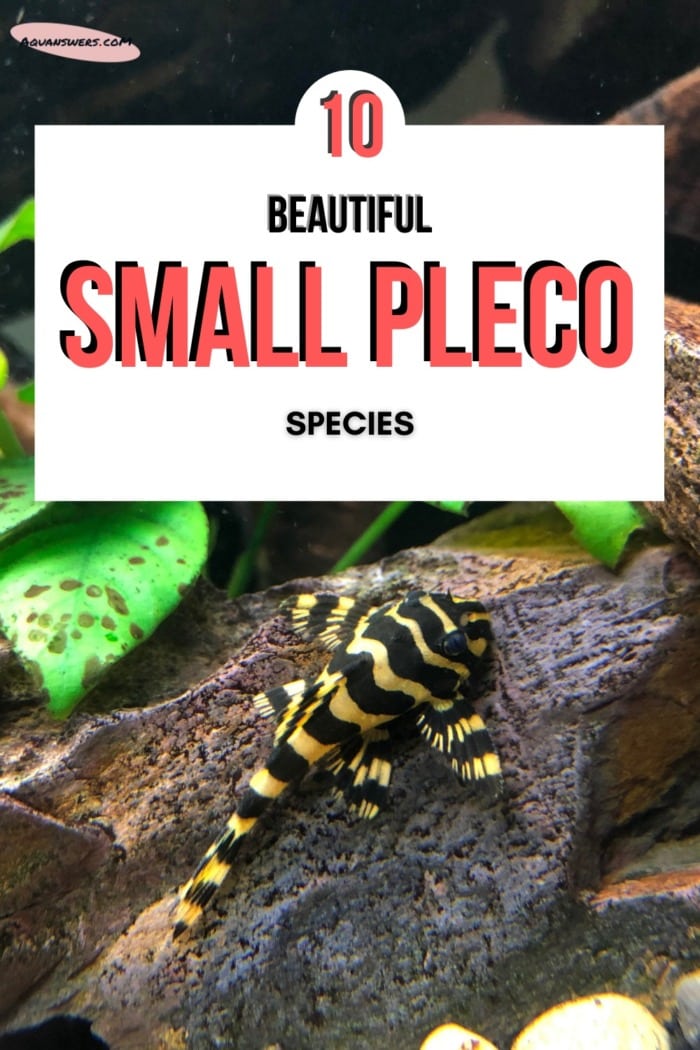


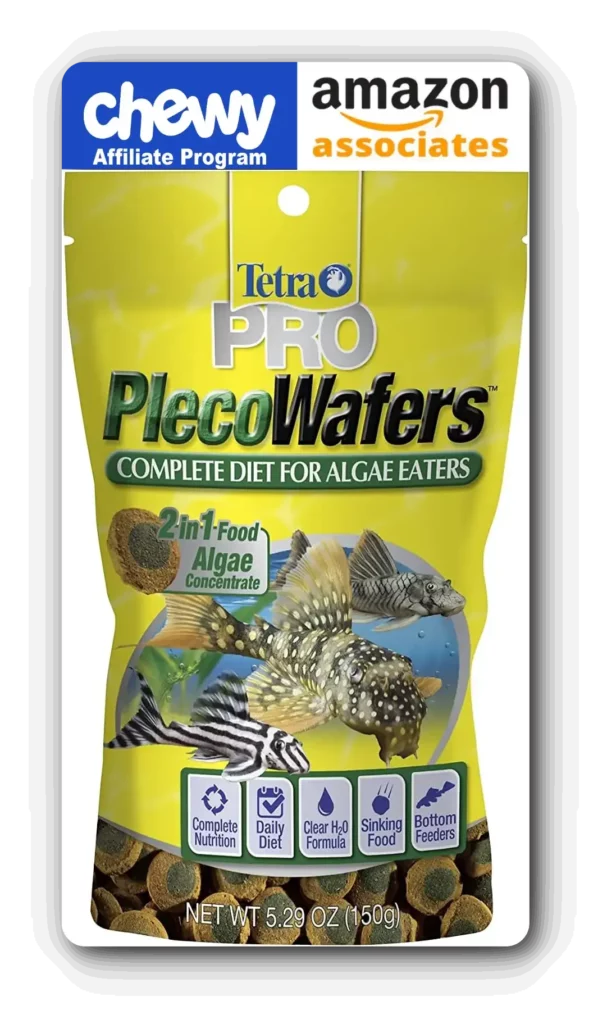
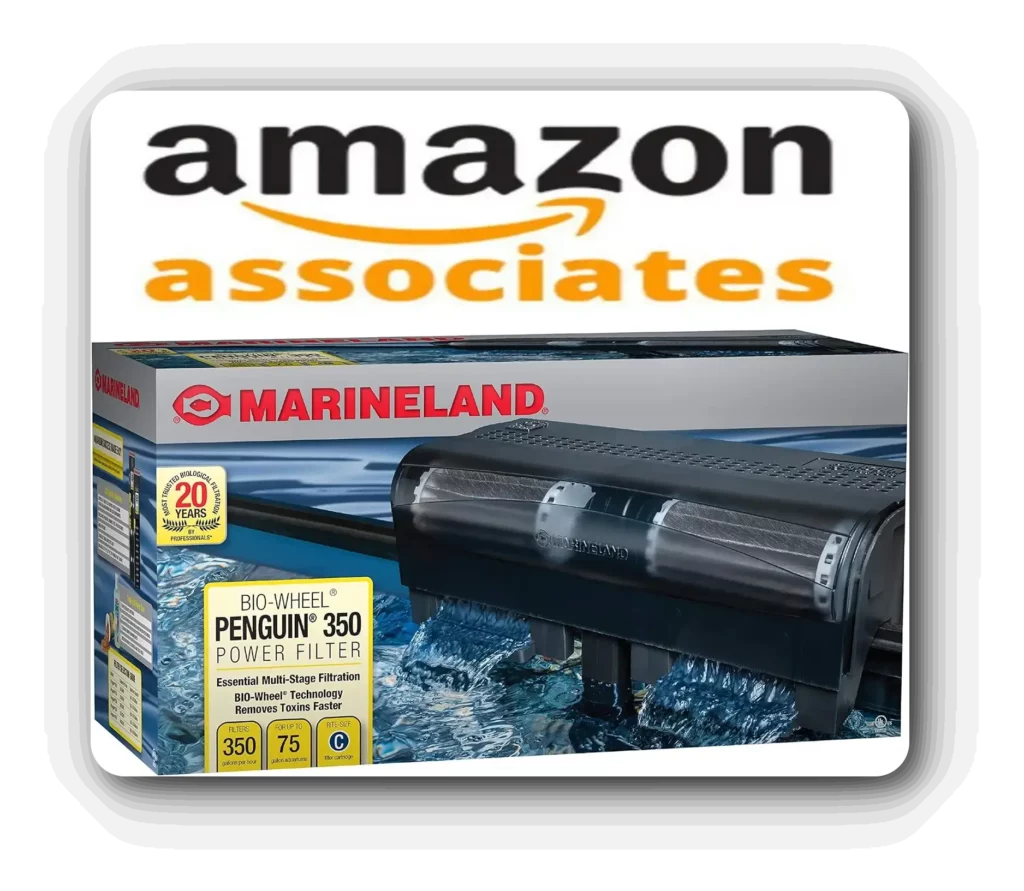
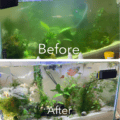
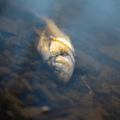
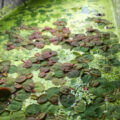
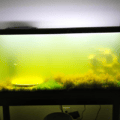
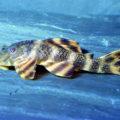


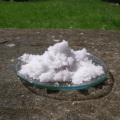


I have a 30 gallon breeder aquarium.I have blood parrot & angel fish would like a pleco what kind should I get?I’m interested in one that does not get large but a nice colored one that stays about 5-6″
Hey, thanks for your comment!
This article below lists 14 small opleco species:
https://aquanswers.com/small-pleco-species/
And this article linked below lists 33 popular pleco species:
https://aquanswers.com/how-big-do-plecos-get/
I hope this helps!
I’ve had a pleco that stayed about 3 cm long for the entire time I’ve had it. It was light yellow, with small white dots. I haven’t given it much thought before, but now I’m a bit curious. Would any of you have any idea what species it was? Or if it was just an odd one out?
I have a 32 gallon fresh water tank and wanted to add a dwarf pleco, but reading all this information , I am unsure . I was under the impression plecos were really good for algea control. I wanted that type of fish to make tank maintenance easier. I have a planted and cycled tank that is ready to add fish. I wanted several kinds of fish. I have started to research all the types of fish. I was wondering if you had any tips or suggestions to decide if its best to add all fishes at once or in stages? I look forward to hearing from you .
Hello,
Depends on the pleco — rubber lipped plecos are good algae eaters, for example. You can also research other small algae eaters like the Otocinclus.
As for your last question – definitely add fish in stages, to help the beneficial bacteria (and therefore Nitrogen cycle) adjust in time.
Good luck, Ellen.
I have a small, less than 2.5”, pleco, doesn’t really match any of these pics. We’ve had him for 8 years. He lives in our 65 gal tank. Depending on the time of day he changes colors. Sometimes turning yellow. Sometimes I see it sleeping upside down. He lives inside a plastic tree trunk. Doesn’t like when I do any tank maintenance and stays hidden for up to two weeks.
Linda,
that’s super interesting. Unfortunately, it doesn’t sound familiar. A hidden gem
i have a pleco but i dont know his type of pleco anyone have a idea? he has spots like the mini snowball pleco but he is bigger than a mini snowball pleco he is about the size of my hand. does anyone know his species of these fish?
No idea, sorry. There are thousands of plecos. You can try going to planetcatfish.com and researching what you have based on looks/size.
Momchil
There is a snowball pleco that is not a dwarf also.
I stumbled on this page while in search of plecos that would do well in my 36 gallon tall/bow front guppy tank that also houses several varieties of corydoras and shrimp. Now I can’t decide! I’m looking for something relatively reliable as an algae cleaner. I have driftwood and dragon stone, and my substrate is fine grain sand. When algae is scarce I have snello for them to feed on, made with spirulina and blue-green algae powders. (I also house mystery snails.)
What are your suggestions?
Hello,
Look into some rubber-lipped plecos but get a juvenile if possible.
I was looking for can live in a 10 gallon tank and found this website. It has all the information that you may need. I certainly recommend it.